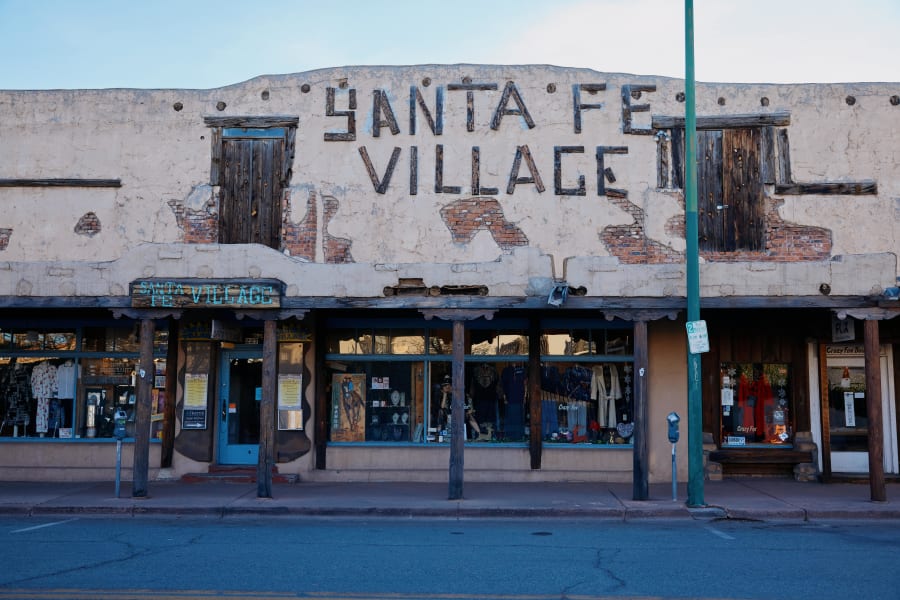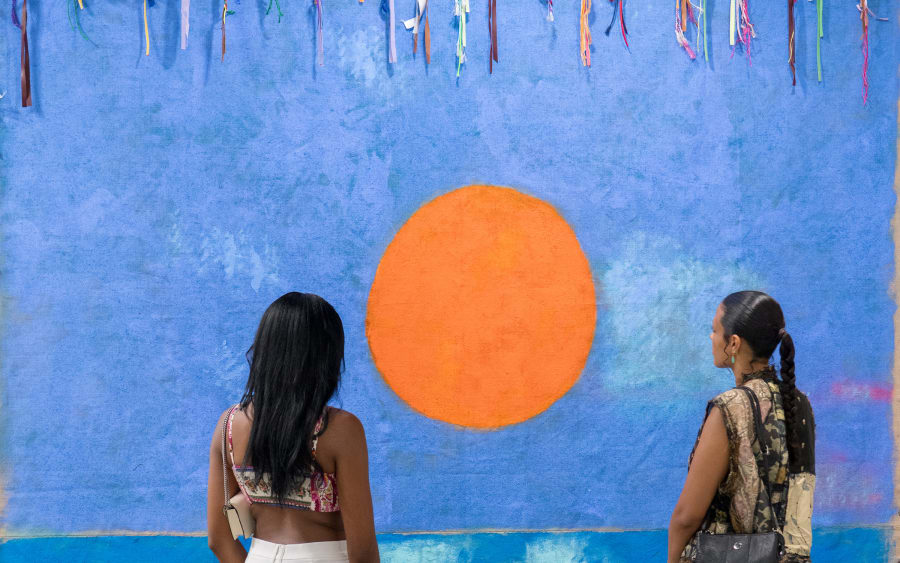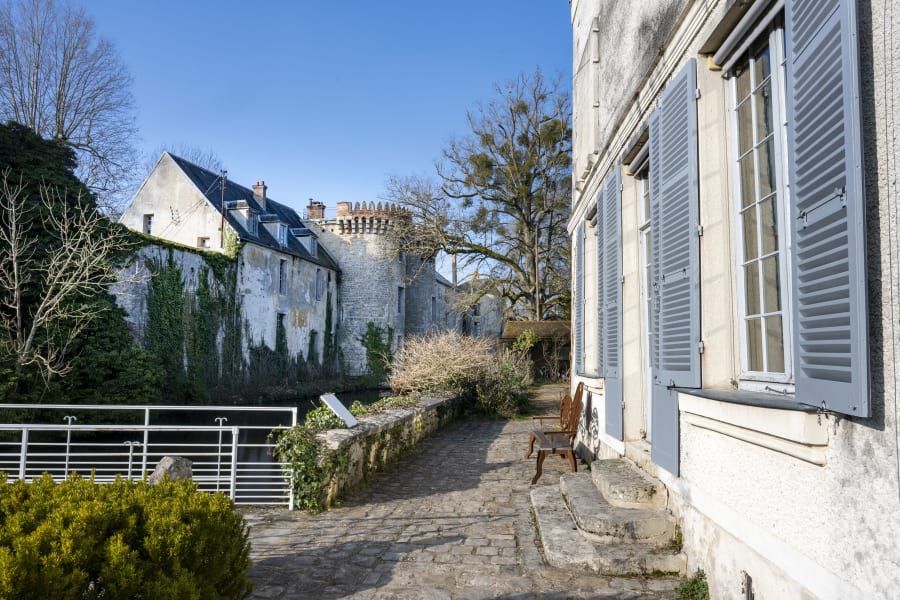For millennia the natural world has been a source of inspiration and subject for artists. But more than appearing in artworks, our natural environment is also often a place for reclusion, a place where artists go to reground themselves. Andrea Zittel, Paulo Nazareth, Julius von Bismarck, Lisa Anne Auerbach, and Olaf Breuning share why they hike, run, or wander – and where.
Andrea Zittel
Lives and works: Joshua Tree, within the Mojave Desert, California
Known for: exploring how our values, social norms, and beliefs are arbitrary and invented, as well as developing and testing new prototypes for living structures and situations
‘I’ve hiked for pretty much my entire life. When I was growing up, our family holidays were based around backpacking and camping, and when I was seven we went backpacking in the Sierra mountains. I remember finding a very remote, abandoned wooden cabin that set off a string of fantasies about being a hermit and living alone high in the mountains – sometimes I wonder if that was the first experience that eventually led to my experiments in living many decades later.
‘For the 22 years that I lived at A-Z West, my compound and art project in the Mojave Desert, hiking was my daily ritual. The main reason I decided to buy the parcel of land that became A-Z West is there’s a very private trail on the south side of the property that leads up into the hills through incredible piles of boulders. I hiked this trail with my dogs every morning before starting my day – and this is the trail I still feel most connected to. At one point there is a huge rock that looks like a fish head, which I’ve painted a few times.
‘Before moving to the desert, I lived in Los Angeles, where I started a hiking club with several other artists called the Feral Spaniels. We would hike into the San Gabriel Mountains on Sundays. After I moved out to the desert, our hiking club continued, eventually being renamed the Interlopers. One year we did a project at Frieze in London – we set up base camp and camped in the fair tent at night and hiked through the city in the daytime.
‘My artwork considers human nature and the contemporary condition, so I don’t overtly feature nature, but because moving through the landscape is such a big part of my life it still seems to creep into my projects. For instance, my newest work, Public Performance of the Self, includes different hikes that I’ve done with my son and with my partner.
‘Once in a while I will hike with others, but I usually prefer to do it alone with my dogs. Hiking and being in the land with no one around is how I recalibrate. I once knew a geologist who believed that rocks had sentience, and I often think about this when I move through the landscape. With everything that is happening to the world right now I find that the deep geologic history of the landscape puts everything into a different perspective. Humans may not survive this world, but the rock formations and mountain ranges will outlast it all – with or without us.’
Paulo Nazareth
Lives and works: around the world
Known for: performances, sculptures, and installations that explore themes including colonialism, globalization, and identity
‘Walk, hike. Walk, hike. When you say the word ‘nomad,’ people think of no land, no home. But for us, for nomads, it is all about the idea of a big territory, of a larger concept of land. It’s about the right of transit, the right of the walker, and the right of crossing borders. It’s about bird migration, it’s about horse migration. It’s about every life, human and non-human, that moves around the land.
‘I walk because it’s my heritage. My mom is Afro-Borun and worked as a street cleaner to limpar caminhos [clear paths]. It’s a physical job, but clearing the way is also spiritual and sacred. Sometimes I also worked as a capinador [weeder] to clean and prepare the land for plantation. My uncle was also a trecheiro or andarilho, which is a very specific word for walker [it loosely translates to “vagabond” or “wanderer”] – it isn’t just about walking but rather a lifestyle.
‘When I think about this heritage, I think about the planet, the Earth, and walking. The car, the train, and even the horse and buggy are very new in our history. Walking, for me, is a way to connect myself with the world and my ancestors, as well as to meditate. Walking becomes a conversation with your body, your DNA, your mind, and your ancestral people. Everything that I do is my art, so walking is also a performance, a dance, a drawing.
‘One place I continually return to is my mom’s kitchen. This isn’t a path or trail, but my mom’s home in Palmital [Minas Gerais state] and the area surrounding it is very important for me [in relation to] thinking about the road, the map, and orientation in the world. It’s not about the arrival, but about the movement, the transit, and my ancestors’ relationship to this place for the past 12,000 years.’
Julius von Bismarck
Lives and works: Berlin, Germany
Known for: questioning how the human idea of ‘nature’ has been constructed, expressed through media ranging from kinetic sculptures to photography and video
‘Hiking is one of the most important things in my life. It started with a house that’s been in my family for three generations in the mountains in Ticino, Switzerland. When I was a baby, I went hiking on my father’s back. As soon as my legs were long enough, I was hiking too. Through all phases of my life, hiking has been there.
‘You see the world differently when you hike. You move constantly but you’re incredibly slow. It distracts you from the noise of life. You look at life as plants, you think about Earth and geology and scales of time. You think about the millions of years that made the mountains, the hundreds of years that made the trees. This also makes it easier to see your life from the outside, like, “OK, I’m 40 years old. What am I doing in my life? Why am I here?” I automatically think about these big, philosophical questions on a mountain, whereas it’s impossible for me to think about them in a city.
‘Hiking is the main thing I do without producing something, but my work does deal a lot with the relationship we have with what we call nature, the world, our environment. I primarily hike in the Alps, and an alp is a human-made, cultural landscape. You have sheep, goats, and cows eating the grass. I don’t know what the Alps would look like without human effect. I don’t think there is anything like wilderness in Europe or even in the whole world anymore, because everything is affected by human life – nature only exists as an idea. And that’s mainly what my work is about – this misunderstanding of the human role in the world. I’m trying to create situations, create images, that question the existing construct of human versus nature.
‘Although I’m mostly hiking in the Alps, one of my favorite hikes is on Lanzarote. It’s like a really good movie – you walk through a volcanic landscape to reach a crater and there’s a dramaturgy of how it begins and moves through cave-like lava channels and areas shaped by the wind before reaching the rim. I discovered it during a random walk – and I won’t tell you exactly where it is because the search for this hike is as interesting as the hike itself.’
Lisa Anne Auerbach
Lives and works: Los Angeles, California
Known for: knit works, photographs, and publications that question agency and voice in a cacophonous world
‘Decades ago, I was part of Andrea Zittel’s hiking club. We were interested in exploring the San Gabriels and started walking there weekly. We also did a project at Frieze in London. Now I live in Mount Washington [a neighborhood in the San Rafael Hills of northeast Los Angeles] and walk a lot there. Across the street from my house, there’s a “monks’ trail,” which I walk almost every day. When I walk there, I have a real awareness of seasonality. I visit certain stands of bamboo and see how they’re doing. I’m also interested in Agave americana, an agave plant that blooms and then dies. Every few years you see one come up, erupt, and die. [This kind of act] is about grounding myself in and being in touch with the part of Los Angeles where I live.
‘I don’t like driving to hikes because for me that defeats the purpose. I prefer walking in my neighborhood, which fortunately has several big, urban hilly parks – right behind my backyard is Elyria Canyon Park, a 35-acre canyon. Having the opportunity to see a creek, be with a tree, and smell the leaves can be very impactful in trying to get my thoughts in order and understanding the priorities of the world. Walking is an opportunity to slow down and, more than anything, think. Although maybe not explicitly, a lot of my work has ecological themes or values, and being around the natural world can be inspiring. You start thinking about the environmental impact of humans, and walking helps reify an understanding of the importance of nature.’
Olaf Breuning
Lives and works: Kerhonkson, New York
Known for: addressing some of life’s biggest questions through universal visual language, often with a healthy dose of humor or satire
‘I hike with my friends through the Catskill Mountains, but running is more suited to me than walking. We have about 45 acres of land and there’s a path from my studio that’s two or three miles uphill and down, so when I’m working in the studio and my energy gets low around 3pm, I run this trail. After half an hour or so, I gain my energy back, I can think about my work again. Before I started running, I also hiked the trails. Walking or running is a repetitive physical activity that makes my brain rest and become more focused. I don’t have a favorite trail where I’m like, “Wow, I have to go there to experience this or that,” but this trail by my studio is important. It doesn’t have a name, although I know the trees, I know the rocks. It has the mark of me walking and running over the years. When I don’t go there, it gets overgrown.
‘I’ve also hiked to specific locations to make works. For The Edge [2024], I hiked two hours on the trail leading to what’s known as Gertrude’s Nose to put a huge blow-up Earth on the edge of a rock and take a photograph. Rocks to me symbolize Earth and nature – a rock is there a hundred or a thousand or millions of years. Unlike a tree or plants, it doesn’t come and go. My work talks a lot about the relationship between humans and nature, and to me, the rock is the opposite of humans. We come and go but the rock doesn’t move.’
Emily McDermott is a writer, editor, and cultural producer living in Berlin.
Caption for header image: Trail behind A-Z West. Photograph by Andrea Zittel.
Published on July 25 2025.


